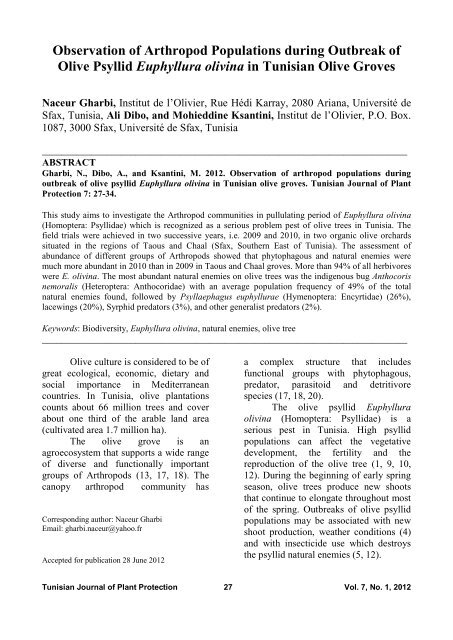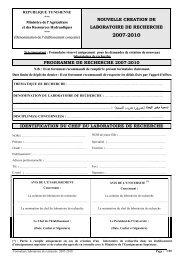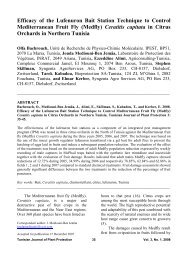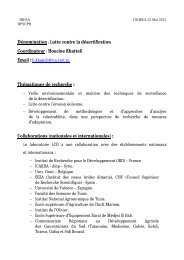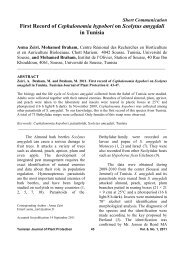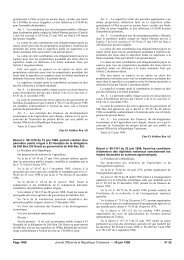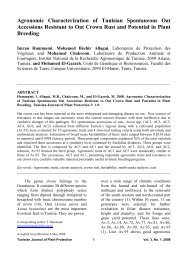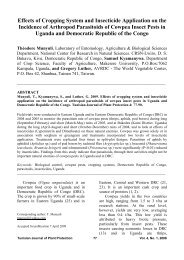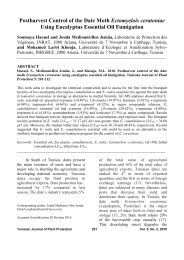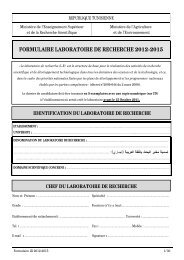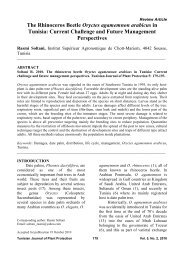Observation of Arthropod Populations during Outbreak of Olive - Iresa
Observation of Arthropod Populations during Outbreak of Olive - Iresa
Observation of Arthropod Populations during Outbreak of Olive - Iresa
Create successful ePaper yourself
Turn your PDF publications into a flip-book with our unique Google optimized e-Paper software.
<strong>Observation</strong> <strong>of</strong> <strong>Arthropod</strong> <strong>Populations</strong> <strong>during</strong> <strong>Outbreak</strong> <strong>of</strong><br />
<strong>Olive</strong> Psyllid Euphyllura olivina in Tunisian <strong>Olive</strong> Groves<br />
Naceur Gharbi, Institut de l’Olivier, Rue Hédi Karray, 2080 Ariana, Université de<br />
Sfax, Tunisia, Ali Dibo, and Mohieddine Ksantini, Institut de l’Olivier, P.O. Box.<br />
1087, 3000 Sfax, Université de Sfax, Tunisia<br />
__________________________________________________________________________<br />
ABSTRACT<br />
Gharbi, N., Dibo, A., and Ksantini, M. 2012. <strong>Observation</strong> <strong>of</strong> arthropod populations <strong>during</strong><br />
outbreak <strong>of</strong> olive psyllid Euphyllura olivina in Tunisian olive groves. Tunisian Journal <strong>of</strong> Plant<br />
Protection 7: 27-34.<br />
This study aims to investigate the <strong>Arthropod</strong> communities in pullulating period <strong>of</strong> Euphyllura olivina<br />
(Homoptera: Psyllidae) which is recognized as a serious problem pest <strong>of</strong> olive trees in Tunisia. The<br />
field trials were achieved in two successive years, i.e. 2009 and 2010, in two organic olive orchards<br />
situated in the regions <strong>of</strong> Taous and Chaal (Sfax, Southern East <strong>of</strong> Tunisia). The assessment <strong>of</strong><br />
abundance <strong>of</strong> different groups <strong>of</strong> <strong>Arthropod</strong>s showed that phytophagous and natural enemies were<br />
much more abundant in 2010 than in 2009 in Taous and Chaal groves. More than 94% <strong>of</strong> all herbivores<br />
were E. olivina. The most abundant natural enemies on olive trees was the indigenous bug Anthocoris<br />
nemoralis (Heteroptera: Anthocoridae) with an average population frequency <strong>of</strong> 49% <strong>of</strong> the total<br />
natural enemies found, followed by Psyllaephagus euphyllurae (Hymenoptera: Encyrtidae) (26%),<br />
lacewings (20%), Syrphid predators (3%), and other generalist predators (2%).<br />
Keywords: Biodiversity, Euphyllura olivina, natural enemies, olive tree<br />
__________________________________________________________________________<br />
<strong>Olive</strong> culture is considered to be <strong>of</strong><br />
great ecological, economic, dietary and<br />
social importance in Mediterranean<br />
countries. In Tunisia, olive plantations<br />
counts about 66 million trees and cover<br />
about one third <strong>of</strong> the arable land area<br />
(cultivated area 1.7 million ha).<br />
The olive grove is an<br />
agroecosystem that supports a wide range<br />
<strong>of</strong> diverse and functionally important<br />
groups <strong>of</strong> <strong>Arthropod</strong>s (13, 17, 18). The<br />
canopy arthropod community has<br />
Corresponding author: Naceur Gharbi<br />
Email: gharbi.naceur@yahoo.fr<br />
Accepted for publication 28 June 2012<br />
a complex structure that includes<br />
functional groups with phytophagous,<br />
predator, parasitoid and detritivore<br />
species (17, 18, 20).<br />
The olive psyllid Euphyllura<br />
olivina (Homoptera: Psyllidae) is a<br />
serious pest in Tunisia. High psyllid<br />
populations can affect the vegetative<br />
development, the fertility and the<br />
reproduction <strong>of</strong> the olive tree (1, 9, 10,<br />
12). During the beginning <strong>of</strong> early spring<br />
season, olive trees produce new shoots<br />
that continue to elongate throughout most<br />
<strong>of</strong> the spring. <strong>Outbreak</strong>s <strong>of</strong> olive psyllid<br />
populations may be associated with new<br />
shoot production, weather conditions (4)<br />
and with insecticide use which destroys<br />
the psyllid natural enemies (5, 12).<br />
Tunisian Journal <strong>of</strong> Plant Protection 27 Vol. 7, No. 1, 2012
The olive psyllid is commonly<br />
consumed by several species <strong>of</strong> generalist<br />
predators (Anthocoridae, Chrysopidae,<br />
Aranae, Coccinellidae, and Miridae) and<br />
many parasitoids (Psyllaephagus<br />
euphyllurae, Alloxista sp., Elasmus sp…).<br />
These natural enemies successfully<br />
control psyllid in some cases (4).<br />
At present, intensive pesticide use<br />
is being held responsible for irreversible<br />
damage to biodiversity, and numerous<br />
alternatives are being investigated in<br />
order to control crop pests (7, 16).<br />
The aim <strong>of</strong> this study was the<br />
monitoring <strong>of</strong> the group <strong>of</strong> <strong>Arthropod</strong>s in<br />
olive groves in the pullulating period <strong>of</strong><br />
E. olivina.<br />
MATERIALS AND METHODS<br />
Orchards. The study areas were<br />
located in two olive groves near Sfax<br />
(Southern East <strong>of</strong> Tunisia): Taous and<br />
Chaal groves with different agricultural<br />
systems. The predominant cultivar is<br />
Chemlali. Both olive groves have been<br />
conducted according to organic growing<br />
guidelines. All olive trees were well<br />
tended, but no pesticide sprays were<br />
applied against pests or diseases, and soil<br />
was ploughed superficially with a<br />
scarifier two to four times a year to<br />
control weeds.<br />
In Taous grove, the planting<br />
density is <strong>of</strong> 7 m × 7 m, the olive trees are<br />
about 10 years old and the field was<br />
irrigated. Chaal grove was planted in<br />
extensive (pluvial) mode with trees about<br />
70 years old spaced 24 m × 24 m apart.<br />
The two biotopes are characterized by a<br />
typical continental climate, cold winters<br />
(5.8°C in January) and very hot summers<br />
(32.2°C in August).<br />
<strong>Observation</strong>s. The survey <strong>of</strong> the<br />
fluctuation <strong>of</strong> psyllid population and<br />
beneficial insects was monitored weekly<br />
by sampling from the beginning <strong>of</strong><br />
February till the end <strong>of</strong> May over a period<br />
<strong>of</strong> 2009 and 2010. Two sampling<br />
techniques were applied in the current<br />
study: beating sheet and branch sampling.<br />
Beating sheet. Ten trees at about<br />
the same stage <strong>of</strong> growth were randomly<br />
selected in each biotope and five branches<br />
per tree were sampled. All captured<br />
individuals were identified under<br />
binocular at the order, family or species<br />
level and the total number <strong>of</strong> each taxon<br />
was recorded.<br />
Branch sampling. Five trees per<br />
site were randomly sampled, five twigs<br />
(10-15 cm in length) were cut per tree,<br />
covered in plastic bags and taken to the<br />
laboratory where they were examined<br />
under binocular and the current stages <strong>of</strong><br />
psyllids (eggs and juveniles) and<br />
parasitoids or predators were counted.<br />
Psyllid stages observed in sample<br />
were expressed in linear density (4, 5)<br />
that represents the total number <strong>of</strong> psyllid<br />
stages on length <strong>of</strong> examined twigs<br />
(number <strong>of</strong> stages/m).<br />
For the assessment <strong>of</strong> the<br />
fecundity <strong>of</strong> E. olivina, females were<br />
sampled weekly and examined in the<br />
laboratory for the presence <strong>of</strong> mature<br />
eggs, after opening their abdomen.<br />
Data analysis. Data were analyzed<br />
with ANOVA using LSD test (SPSS<br />
version 17). If necessary data were<br />
transformed using the Log-transformation<br />
for normal distribution and homogeneity<br />
<strong>of</strong> variances.<br />
RESULTS<br />
Beating sheet results. The<br />
assessments <strong>of</strong> abundance <strong>of</strong> the different<br />
groups <strong>of</strong> arthropods in the regions <strong>of</strong><br />
Taous and Chaal from February till end <strong>of</strong><br />
May over two years, a total <strong>of</strong> 60117<br />
insects were captured, among which<br />
51493 were herbivores and 8684 were<br />
natural enemies. Phytophagous and<br />
Tunisian Journal <strong>of</strong> Plant Protection 28 Vol. 7, No. 1, 2012
natural enemies were much more<br />
abundant in 2010 than in 2009 survey in<br />
Taous and Chaal groves. More than 94%<br />
<strong>of</strong> all herbivores were E. olivina (a total<br />
<strong>of</strong> 48490 individuals; sex ratio:<br />
male/female = 0.88/1). High population<br />
densities <strong>of</strong> psyllid occurred between the<br />
beginning <strong>of</strong> March till the end <strong>of</strong> May<br />
with two peaks; the first peak in the<br />
middle <strong>of</strong> March and the second one at<br />
the end <strong>of</strong> April. Other herbivores were<br />
olive moth, Prays oleae (Lepidoptera:<br />
Yponomeutidae) (4%) and Liothrips<br />
oleae (Thysanoptera: Phlaeothripidae) (<<br />
2%).<br />
The most abundant natural<br />
enemies on olive trees was Anthocoris<br />
nemoralis (Heteroptera: Anthocoridae)<br />
with an average population frequency <strong>of</strong><br />
49%, <strong>of</strong> the total <strong>of</strong> natural enemies<br />
found, followed by Psyllaephagus<br />
euphyllurae (Hymenoptera: Encyrtidae)<br />
(26%), green and brown lacewings<br />
(Neuroptera: Chrysopidae) (20%),<br />
Syrphid predators (Diptera: Syrphidae)<br />
(3%) and other generalist predators (2%).<br />
Mean numbers <strong>of</strong> E. olivina were<br />
significantly different between Taous and<br />
Chaal groves (Table 1). In contrast, there<br />
were significant location effects on the<br />
mean numbers <strong>of</strong> A. nemoralis and P.<br />
euphyllurae from February till end <strong>of</strong><br />
May samplings in both years (2009 and<br />
2010). In all cases, Taous grove had<br />
higher densities <strong>of</strong> these insects than<br />
Chaal grove. The effect <strong>of</strong> location by<br />
year interaction on the linear densities <strong>of</strong><br />
E. olivina was not significant (F3, 19 =<br />
1.097, P = 0.31). However, the locationyear<br />
interactions have no effects on the<br />
abundance <strong>of</strong> P. euphyllurae and A.<br />
nemoralis. Both P. euphyllurae and A.<br />
nemoralis were more abundant in Taous<br />
than Chaal grove in each <strong>of</strong> collection<br />
periods.<br />
Mean numbers <strong>of</strong> Chrysopid and<br />
Syrphid predators were not significantly<br />
different between Taous and Chaal<br />
groves. However, <strong>during</strong> both years, the<br />
mean numbers <strong>of</strong> Chrysopid and Syrphid<br />
predators were higher in Taous than in<br />
Chaal.<br />
In two orchards, every year, some<br />
predator species such as Chrysoperla<br />
carnea (Neuroptera: Chrysopidae) were<br />
present at low number before the growth<br />
<strong>of</strong> phytophagous populations. Overall,<br />
predator populations started to increase in<br />
numbers from March to mid May,<br />
especially for A. nemoralis. Furthermore,<br />
P. euphyllurae was observed especially in<br />
the period between mid April and mid<br />
May, and it was not frequently observed<br />
at the last period <strong>of</strong> observations<br />
(beginning <strong>of</strong> May), because the psyllid<br />
nymphs were absent in this period (Fig.<br />
1).<br />
Branch sampling results. The<br />
total number <strong>of</strong> collected E. olivina<br />
nymphs was 84623 and a total <strong>of</strong> 119309<br />
psyllid eggs were sampled. The structure<br />
<strong>of</strong> psyllid population was composed by<br />
68% young instars (L1, L2 and L3) and<br />
32% old instars (L4 and L5). The total<br />
number <strong>of</strong> immature mortality was 1287,<br />
with 65% <strong>of</strong> them consumed by natural<br />
enemies.<br />
Significantly, there were more<br />
eggs and immatures <strong>of</strong> E. olivina in<br />
Taous than Chaal <strong>during</strong> the sampling<br />
period. Also, mean proportion <strong>of</strong> intact<br />
immature was statistically similar in<br />
Taous than Chaal from March to mid<br />
May (Table 2). However, Taous had<br />
higher proportion <strong>of</strong> immatures<br />
parasitized than Chaal. Likewise, mean<br />
proportion <strong>of</strong> immatures consumed was<br />
higher in Taous than Chaal <strong>during</strong> the<br />
sampling period.<br />
Tunisian Journal <strong>of</strong> Plant Protection 29 Vol. 7, No. 1, 2012
Table 1. Phytophagous and predaceous insects occurring on olive trees colonized by Euphyllura olivina in<br />
Taous and Chaal groves <strong>during</strong> two years 2009 and 2010 (Sampling period: February - May)<br />
Insect species Mean number (± SE) <strong>of</strong> insects a Statistical values<br />
Sampling year Taous Chaal F P<br />
2009<br />
Phytophagous<br />
Euphyllura olivina<br />
Prays oleae<br />
Liothrips oleae<br />
Predaceous<br />
Anthocoris nemoralis<br />
Psyllaephagus euphyllurae<br />
Chrysopid predators<br />
Syrphid predators<br />
2010<br />
Phytophagous<br />
Euphyllura olivina<br />
Prays oleae<br />
Liothrips oleae<br />
Predaceous<br />
Anthocoris nemoralis<br />
Psyllaephagus euphyllurae<br />
Chrysopid predators<br />
Syrphid predators<br />
134.27 ± 42.09 a<br />
3.71 ± 0.41 a<br />
1.50 ± 0.61 a<br />
5.56 ± 1.86 a<br />
3.06 ± 0.85 a<br />
2.44 ± 0.69<br />
0.30 ± 0.18<br />
171.21 ± 65.29 a<br />
2.62 ± 0.84<br />
2.06 ± 0.43 a<br />
7.93 ± 1.02 a<br />
3.93 ± 0.87 a<br />
2.64 ± 0.66<br />
0.38 ± 0.04<br />
83.26 ± 24.67 b<br />
1.82 ± 0.35 b<br />
0.94 ± 0.11 b<br />
3.05 ± 1.12 b<br />
1.78 ± 0.55 b<br />
2.06 ± 0.47<br />
0.23 ± 0.08<br />
92.29 ± 31.30 b<br />
2.28 ± 0.63<br />
0.72 ± 0.07 b<br />
4.18 ± 0.82 b<br />
2.18 ± 0.54 b<br />
2.53 ± 0.59<br />
0.37 ± 0.02<br />
F1,31 = 5.91<br />
F1,31 = 8.67<br />
F1,31 = 4.25<br />
F1,31 = 12.253<br />
F1,31 = 6.321<br />
F1,31 = 3.662<br />
F1,31 = 2.698<br />
F1,31 = 23.051<br />
F1,31 = 0.543<br />
F1,31 = 21.066<br />
F1,31 = 24.514<br />
F1,31 = 6.124<br />
F1,31 = 9.546<br />
F1,31 = 0.776<br />
0.0410<br />
0.0331<br />
0.0110<br />
0.0421<br />
0.0341<br />
0.0708<br />
0.0927<br />
0.0013<br />
0.8761<br />
0.0012<br />
0.0134<br />
0.0112<br />
0.0638<br />
0.3847<br />
a Data show mean number (± SE) <strong>of</strong> insects per tree. Means followed by the same letter within a line are not<br />
significantly different according to LSD test at P < 0.05.<br />
Table 2. Mean number <strong>of</strong> immature stage <strong>of</strong> Euphyllura olivina on olive trees in Taous and Chaal groves <strong>during</strong><br />
two years 2009-2010 (Sampling period: February-May)<br />
Sampling year<br />
Mean linear density (± SE)<br />
<strong>of</strong> E. olivina<br />
Mean proportions (± SE) <strong>of</strong> Nymphs a<br />
Grove site<br />
2009<br />
Eggs Nymphs Intact Parasitized Consumed<br />
Taous 93.997 ± 28.951 a 52.875 ± 11.517 a 0.810 ± 0.052 a 0.054 ± 0.016 a 0.136 ± 0.038 a<br />
Chaal 59.752 ± 22.814 b 28.806 ± 11.506 b 0.935 ± 0.014 b 0.021 ± 0.006 b 0.043 ± 0.011 b<br />
F1,31 3.923<br />
17.013<br />
26.032<br />
17.470<br />
26.728<br />
P 0.036<br />
0.003<br />
0.00927<br />
0.00308<br />
0.00085<br />
2010<br />
Taous 146.961 ± 34.184 a 67.373 ± 18.419 a 0.616 ± 0.102 a 0.078 ± 0.014 a 0.306 ± 0.089 a<br />
Chaal 76.984 ± 31.526 b 32.579 ± 17.291 b 0.856 ± 0.024 b 0.049 ± 0.013 b 0.095 ± 0.018 b<br />
F1,31 29.358<br />
26.401<br />
25.875<br />
11.691<br />
26.363<br />
P 0.00923<br />
0.00817<br />
0.00945<br />
0.00909<br />
0.00089<br />
a<br />
Means followed by the same letter within a line are not significantly different according to LSD test at P < 0.05.<br />
Tunisian Journal <strong>of</strong> Plant Protection 30 Vol. 7, No. 1, 2012
Fig. 1. Linear densities <strong>of</strong> the different stages <strong>of</strong> Euphyllura olivina in Taous and Chaal groves <strong>during</strong> 2009<br />
and 2010 (Sampling period: February-May).<br />
Tunisian Journal <strong>of</strong> Plant Protection 31<br />
Vol. 7, No. 1, 2012
DISCUSSION<br />
In this study, the representative<br />
orders in olive orchard were Homoptera,<br />
Lepidoptera, Neuroptera, Thysanoptera<br />
and Coleoptera varying in proportion<br />
between groves and years. These groups<br />
have been reported in the literature as<br />
typically the abundant groups in olive<br />
groves (3, 11, 19). These orders include<br />
key-groups <strong>of</strong> predators, parasitoids and<br />
phytophagous. Natural enemies play an<br />
important role in the biological control <strong>of</strong><br />
olive pests like P. oleae and E. olivina (8,<br />
13, 14, 15).<br />
In Tunisia, the list <strong>of</strong> natural<br />
enemies <strong>of</strong> E. olivina is composed by 14<br />
species (11) that were recorded with<br />
different frequencies that varied<br />
according to species belonging to four<br />
families: Anthocoridae, Chrysopidae,<br />
Coccinellidae and Encyrtidae. The first<br />
three families include many predator<br />
species: A. nemoralis, C. carnea and<br />
Coccinella septempunctata (Coleoptera:<br />
Coccinellidae), and the fourth includes<br />
the endoparasitoid P. euphyllurae (4, 11).<br />
The role <strong>of</strong> herbivore induced volatiles in<br />
the searching behavior <strong>of</strong> predators like<br />
A. nemoralis and C. carnea under field<br />
conditions was studied (6).<br />
During both years <strong>of</strong> study, total<br />
abundance <strong>of</strong> arthropods was higher in<br />
Taous than in Chaal olive grove.<br />
However, this higher abundance is a<br />
result <strong>of</strong> the high number <strong>of</strong> Homoptera,<br />
which is due to the presence <strong>of</strong> the olive<br />
pest E. olivina. Our observations show<br />
clearly that E. olivina is a serious pest <strong>of</strong><br />
olive crop. Early attacks, especially in the<br />
spring, cause considerable damage to<br />
flowers and subsequent losses in both<br />
quality and quantity <strong>of</strong> olive fruits (5).<br />
Throughout the growing season, mid-<br />
February to the end <strong>of</strong> May, only E.<br />
olivina was constantly present. High<br />
population densities occurred at mid<br />
March to the end <strong>of</strong> May with two peaks:<br />
the first peak at the mid-March and the<br />
second peak in the second half <strong>of</strong> April<br />
(Fig. 1).<br />
The largest percentages <strong>of</strong> mature<br />
females <strong>of</strong> E. olivina were recorded<br />
<strong>during</strong> the period between early February<br />
and late April. Generally, the peak <strong>of</strong> egg<br />
laying occurred in the second week <strong>of</strong><br />
March (around 75 to 95% <strong>of</strong> total females<br />
respectively in 2009 and 2010) and<br />
remained high until mid-April (more than<br />
50% <strong>of</strong> total females), explaining the<br />
significant increase in its population size<br />
<strong>during</strong> the spring months (Fig. 1).<br />
In this evaluation, the most<br />
abundant predator found on olive in Sfax<br />
area was A. nemoralis with an average<br />
population frequency varying between 33<br />
and 41% <strong>of</strong> the total natural enemies<br />
found. Anthocorids are not abundant on<br />
olive early in spring. Its population starts<br />
to increase in numbers by mid-March,<br />
peaking at the end <strong>of</strong> April, coinciding<br />
with that <strong>of</strong> E. olivina, and representing<br />
the major part <strong>of</strong> the predator populations<br />
found on olive tree <strong>during</strong> the spring.<br />
This indicates the positive relationship<br />
occurring between E. olivina and A.<br />
nemoralis in olive orchards. This<br />
predator, A. nemoralis, can be reared<br />
easily and cheaply and is readily<br />
available. There are many reports<br />
describing the role <strong>of</strong> this predator in the<br />
biological control <strong>of</strong> E. olivina<br />
populations (2). However, little is known<br />
on their role in olive orchard and this<br />
needs to be clarified.<br />
The two years <strong>of</strong> this survey have<br />
provided useful and promising data as a<br />
basis for further research in the effective<br />
sustainable management <strong>of</strong> P.<br />
euphyllurae, A. nemoralis and C. carnea<br />
populations, which constitute the most<br />
important group <strong>of</strong> natural enemies <strong>of</strong><br />
insect pests recorded in olive orchards.<br />
Tunisian Journal <strong>of</strong> Plant Protection 32 Vol. 7, No. 1, 2012
__________________________________________________________________________<br />
RESUME<br />
Gharbi N., Dibo A. et Ksantini M. 2012. <strong>Observation</strong> des populations d’arthropodes durant la<br />
période de pullulation du psylle de l’olivier dans les oliveraies tunisiennes. Tunisian Journal <strong>of</strong><br />
Plant Protection 7: 27-34.<br />
Ce travail vise l’étude de la communauté des arthropodes durant la période de pullulation d'Euphyllura<br />
olivina (Homoptera: Psyllidae), un ravageur majeur des oliviers en Tunisie. Le suivi s’est étendu sur<br />
deux années successives 2009 et 2010, dans deux oliveraies biologiques localisées dans les régions de<br />
Taous et Chaal (Sfax, Sud-Est de la Tunisie). L’évaluation de l’abondance des différents groupes<br />
d’arthropodes montrent que les phytophages et les auxiliaires étaient plus abondants en 2010 qu’en<br />
2009 dans les oliveraies Taous et Chaal. Plus que 94% de la totalité des phytophages collectés est<br />
composée d’E. olivina. L’ennemi naturel le plus rencontré est la punaise prédatrice Anthocoris<br />
nemoralis (Heteroptera: Anthocoridae) avec une population moyenne de 49% de la totalité des<br />
auxiliaires collectés, suivi de Psyllaephagus euphyllurae (Hymenoptera: Encyrtidae) (26%), des<br />
chrysopes (20%), des syrphes (3%) et d’autres prédateurs généralistes (2%).<br />
Mots clés: Biodiversité, ennemis naturels, Euphyllura olivina, olivier<br />
__________________________________________________________________________<br />
���ﻣ<br />
ﻼ��ﺑ ﻲ��ﺗ ة��ﻓ لﻼﺧ �ﺟرﻷا تﺎ����ﻣ تﺎﻋ����ﻟ<br />
�ﺻر . 2002 . ﻲ�����ﻗ �ﻳ�ﻟا ﻲ�ﻣو ��ﻳد ﻲ�ﻋو �ﺻﺎﻧ ،ﻲﺑ�ﻐﻟا<br />
. ���ﻧ��ﻟا ن��ﻳ�ﻟا ��ﺗﺎ�ﺑ ﻲﻓ Euphyllura olivina ن��ﻳ�ﻟا<br />
Tunisian Journal <strong>of</strong> Plant Protection 7: 27-34.<br />
Euphyllura olivina ن��ﻳ�ﻟا ﻼ��ﺑ �ﺛﺎ��ﻟ ���ﻼ�ﻟا ة���ﻟا لﻼﺧ �ﺟرﻷا تﺎ����ﻣ ع��ﺗ �ﺳارد ﻰﻟإ ��ﻌﻟا ا�ه ف�ﻬﻳ<br />
��ﻣﺎﻋ لﻼﺧ �ﺳار�ﻟا ه�ه �ﻳ�ﺟأ . �ﻧ�ﺗ ﻲﻓ ن��ﻳ�ﻟا<br />
رﺎ�ﺷﻷ �ﻳ�ﺟ ����ﻣ ّ�ﻌﺗ ﻲ�ﻟاو ،(Homoptera:<br />
Psyllidae)<br />
ﻲﻗ��ﻟا ب���ﻟا ،�ﻗﺎ�ﺻ)<br />
لﺎﻌ�ﻟاو سووﺎ�ﻟا ْﻲ�����ﺑ �ﻳ�ﻀﻋ/<br />
��ﺟ�ﻟ��ﺑ ن��ﻳز ��ﺗﺎ�ﺑ ﻲﻓ ،2010<br />
و 2009 ���ﻟﺎ��ﻣ<br />
لﻼﺧ �ﻓوأ �ﻧﺎآ ��ﻌ���ﻟا ءا�ﻋﻷاو ��ﺗﺎ��ﻟا تﺎﻓﻵا نأ �ﺟرﻷا تﺎ����ﻣ<br />
�ﻣ �����ﻣ<br />
تﺎﻋﺎ�ﺟ ة�ﻓو �ﻳ��ﺗ<br />
�ﻬ�أ . ( ﻲ�ﻧ��ﻟا<br />
�ﻣ % 94 �ﻣ ��آأ ﺎهد���ﺑ ن��ﻳ�ﻟا ﻼ��ﺑ ���ﻣ<br />
�ﻗو . لﺎﻌ�ﻟاو<br />
سووﺎ�ﻟا ْﻲﻧﺎ��ﺑ ﻲﻓ ،2009<br />
��ﺳ ﻲﻓ ��ﻣ 2010 ��ﺳ<br />
Anthocoris nemoralis (Heteroptera: ﻲﻌ���ﻟا و�ﻌﻟا نﺎآو . ﺎﻬﻌ�ﺟ �ﺗ ﻲ�ﻟا ��ﺷﺎﻌﻟا تﺎﻓﻵا دا�ﻋأ ع���ﻣ<br />
����ﻟا هﻼﺗ ،ﺎﻬﻌ�ﺟ<br />
�ﺗ ﻲ�ﻟا ��ﻌ���ﻟا ءا�ﻋﻷا ع���ﻣ �ﻣ % 49 ـﺑ ر��ﻳ ل�ﻌ�ﺑ ًارﺎ��ﻧا ��آﻷا Anthocoridae)<br />
��ﻓ��ﻟا بﺎﺑ�ﻓ<br />
(% 20)<br />
��ﻟا �ﺳأ �ﺛ (% 26)<br />
Psyllaephagus euphyllurae (Hymenoptera: Encyrtidae)<br />
.(% 2)<br />
�����ﻟا ��ﻏ تﺎﺳ����ﻟا �ﻌﺑ ���ﻌ� ����ﺑو ا��ﺧأو (% 3)<br />
Euphyllura olivina ،ن��ﻳ�ﻟا ة��ﺷ ،ﻲﺟ�ﻟ���ﻟا ع���ﻟا ، ��ﻌ���ﻟا ءا�ﻋﻷا : ��ﺣﺎ��ﻣ تﺎ��آ<br />
__________________________________________________________________________<br />
LITERATURE CITED<br />
1. Arambourg, Y. 1984. La fauna olive grove in northern Tuscany. Agr.<br />
entomologica del olivo. Olivae 4: 14- Mediterranica 125: 184-192.<br />
21.<br />
4. Chermiti, B. 1989. Dynamique des<br />
2. Arambourg, Y. and Chermiti, B. 1986. populations du psylle de l’olivier<br />
Euphyllura olivina Costa (Hom. Euphyllura olivina, en conditions<br />
Psyllidae). Pages 163-171. Traité méditerranéennes. PhD Thesis. Es-Sc.,<br />
d’entomologie oléicole. Edition Univ. Aix Marseille, France, 224 pp.<br />
Conseil Oléicole International. 5. Chermiti, B. 1992. Approche<br />
Madrid, Espagne.<br />
d’évaluation de la nocivité du psylle<br />
3. Belcari, A. and Dagnino, A. 1995. de l’olivier Euphyllura olivina (Costa)<br />
Preliminary study <strong>of</strong> the insects (Homoptera,Aphalaridae). Olivae 43:<br />
caught by a ‘‘malaise’’ trap in an 34-42.<br />
Tunisian Journal <strong>of</strong> Plant Protection 33 Vol. 7, No. 1, 2012
6. Drukker, B., Scutareanu, P., and<br />
Sabelis, M.W. 1995. Do anthocorid<br />
predators respond to synomones from<br />
Psylla-infested pear trees under field<br />
conditions? Entomol. Exp. Appl. 77:<br />
193-203.<br />
7. Huang, J., Pray, C., and Rozelle, S.<br />
2002. Enhancing the crops to feed the<br />
poor. Nature 418: 678-684.<br />
8. Iperti, G. 1999. Biodiversity <strong>of</strong><br />
predaceous coccinellidae in relation to<br />
bioindication and economic<br />
importance. Agr. Ecosyst. Environ.<br />
74: 323-342.<br />
9. Jardak, T., Jerraya, A., and Mahjoub,<br />
M. 2004. La protection intégrée de<br />
l’oléiculture dans les pays de<br />
l’Afrique du Nord, SNEA-Tunis, 22<br />
pp.<br />
10. Jardak, T., Moalla, M., Khalfallah, H.,<br />
and Smiri, H. 1985. Essais<br />
d’évaluation des dégâts causés par le<br />
psylle de l’olivier Euphyllura olivina<br />
(Homoptera, Psyllidae). Données<br />
préliminaires sur le seuil de<br />
nuisibilité. Pages 270-284.<br />
Proceedings <strong>of</strong> CEC/FAO/IOBC. Int.<br />
Joint Meeting, 24 November, 1985,<br />
Pisa, Italy.<br />
11. Ksantini, M. 2003. Contribution à<br />
l’étude de la dynamique des<br />
populations du psylle de l’olivier<br />
Euphyllura olivina (COSTA)<br />
(Homoptera- Sternorhyncha-<br />
Aphalaridae) et de sa nuisibilité dans<br />
la région de Sfax. PhD Thesis. Sc-Bio.<br />
Fac. Sc. Sfax, Tunisia, 306 pp.<br />
12. Ksantini, M., Jardak, T., and Bouain,<br />
A. 2002. Temperature effect on the<br />
biology <strong>of</strong> Euphyllura olivina Costa.<br />
Acta Hort. 586: 827-830.<br />
13. Morris, T.I., Campos, M., Kidd,<br />
N.A.C., Jervis, M.A., and Symondson,<br />
W.O.C. 1999. Dynamics <strong>of</strong> the<br />
predatory arthropod community in<br />
Spanish olive orchards. Agric. For.<br />
Entomol. 1: 219-228.<br />
14. Morris, T.I., Symondson, W.O.C.,<br />
Kidd, N.A.C., and Campos, M., 2004.<br />
The effect <strong>of</strong> different ant species on<br />
the olive moth, Prays oleae (Bern.), in<br />
Spanish olive orchard. J. Appl.<br />
Entomol. 126: 224-230.<br />
15. Obrycky, J.J. and Kring, T.J. 1998.<br />
Predaceous coccinellidae in biological<br />
control. Annu. Rev. Entomol. 43: 295-<br />
321.<br />
16. Ortiz, R. 1998. Critical role <strong>of</strong> plant<br />
biotechnology for the genetic<br />
improvement <strong>of</strong> food crops:<br />
perspectives for the next millenium. J.<br />
Biotechnol. 1: 1-8.<br />
17. Rodriguez, E., Campos, M., Sanchez-<br />
Raya, A.J., and Pena, A. 2003. Effect<br />
<strong>of</strong> the combined treatment <strong>of</strong><br />
insecticides and an attractant for the<br />
control <strong>of</strong> Phloeotribus<br />
scarabaeoides, a pest <strong>of</strong> Olea<br />
europaea. Pest Manag. Sci. 59: 339-<br />
346.<br />
18. Ruano, F., Lozano, C., Garcia, P.,<br />
Pena, A., Tinaut, A., and Pascual, F.<br />
2004. Use <strong>of</strong> arthropods for the<br />
evaluation <strong>of</strong> the olive-orchard<br />
management regimes. Agr. Forest<br />
Entomol. 6: 111-120.<br />
19. Ruano, F., Lozano, C., Tinaut, A.,<br />
Pena, A., Pascual, F., Garcia, P., and<br />
Campos, M. 2001. Impact <strong>of</strong><br />
pesticides on beneficial arthropod<br />
fauna in olive orchards. Bull.<br />
OILB/SROP 24: 113-120.<br />
20. Suckling, D.M., Burnip, G.M.,<br />
Hackett, J., and Daly, J.C. 2006. Mass<br />
sampling and baiting indicate<br />
European earwig (Forficula<br />
auricularia) foraging in orchards. J.<br />
Appl. Entomol. 130: 263-267.<br />
----------------<br />
Tunisian Journal <strong>of</strong> Plant Protection 34 Vol. 7, No. 1, 2012


